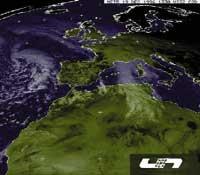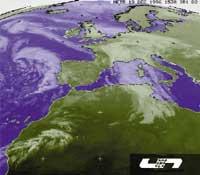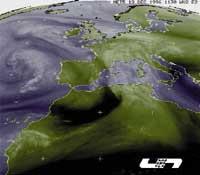Butterfly wings
1997/01/01 Hernandez Iruretagoiena, Juan Carlos Iturria: Elhuyar aldizkaria
Can we therefore say that weather forecasting will improve without limits as science and technology advances? Let's ask this question differently: Will we today accurately imagine the climate of eight or, rather, predict? We believe not. It is not enough to overtake enough to make more accurate predictions. We believe that intrinsically immense factors will influence prediction by reducing its reliability. Let's take an extreme example.
Caribbean Butterfly

What influence does the flight of a pinpilipaux have on the coast of a Caribbean island over time? That is, when flying, the movement of the wings over the air that is in contact with the butterfly causes a disturbance. The disturbance will affect, to a greater or lesser extent, the surrounding air at one time or another. This air will push the one next to him and modify the state of the air in contact with him, extending the chain of effects to the skies of the Basque Country.
The effect of the butterfly flight will sometimes be despicable. And as for the forecasts of a couple of days, so it will probably be despicable. Proof of this are the very predictions for this period: we have said that it is correct in most cases, at least in stable conditions of the sky. He says that a front will come and that the south wind will blow us and we will go crazy the next day... It seems that we can forget the butterfly without big problems.
Degree of rejection

We know — because science has been very evolving — that when analyzing the movement of a truck we don't have to consider Einstein, Newton is enough. “I will calculate the values of independent variables and dependent variables. If I have the speed of the truck and I know where it is going, I will tell you the time it will take getting right”. That is, classical physics is a very useful tool with trucks. We are quite deterministic in some areas: the pencil I have in my hand is released and I fall, we have no doubt about it. For centuries the human being has evolved throughout his life accompanying classical physics.
Its beginnings were undeniable. But before we used the pen and now we write on computer. On this path science has already carried out more than one exercise of humility: it has had to accept the theory of relativity, we have often begun to take into account the implicit influence of measurement itself in the phenomenon that is quantified; the methods of approximation have become indispensable; the agents that were considered unimportant, those that we discarded easily, we have had to remember again and measure their effect. The same happens in the case that concerns us and advertisers do not correct because they discard the effect of the butterfly flight. If their calculations also include this factor, predictions could be safer.
Increasingly better non-stop measurements?

Today, satellites collect data from thousands of weather observatories around the world: atmospheric pressure, temperature and many other parameters are collected periodically at observatories across the Earth, as well as spectacular photographs. It is believed that the better the measuring devices, the more accurate they will be. But does that have no limits?
Suppose we have all the meters you want distributed around the world. Keep in mind that these meters are able to detect every part of the air of Euskal Herria from the air surrounding the Caribbean butterfly. According to the basic kinetic molecular theory that interprets the properties of gases, molecular shocks cause air pressure and temperature.
The latter directly affect air movement. If at any given moment we know the position of each of the molecules that make up the air, can we know where they will be at the next moment? If we were able to detect each shock, we could predict the next position. But if the detectors are as small as we want, they give us the direction and position of each molecule, we will surely need many appliances to fill the space that occupies the air throughout the atmosphere.

However, and despite giving each of the inhabitants of the world their oxygen scuba, in order to measure each impact, the meters will modify at one time or another the expected movement and the forecast made will be cancelled and the total measurement should start at zero. It seems that we are not going to advance in this aspect either.
Theory of Relativity
Anyway, we will move forward without despair and think that we invented a global computer model. The computer processes all the data you want. Also the calculation speed so that we can accelerate what we want. However, unfortunately or fortunately, we will have to accept a limitation: According to Einstein's theory of relativity, our universe has the maximum speed, the speed of light, that is, the maximum speed in nature.
It is a number of a lot of zeros, yes, but limited. We will introduce the data at that speed: three hundred million data per second. In order to make a one-week forecast, how many specific data should we enter? Under normal conditions, that is, at a temperature of 25ºC and a pressure of 1 atm, it can be said that in a liter of air there are approximately 3 x 1.022 molecules, that is, introducing three hundred million data per second, we will need almost two minutes to enter data of one liter. In a week there are 10,080 minutes, so we can enter the data corresponding to 5,040 liters. Without big calculations, anyone knows that in our atmosphere there is much more litres of air than that.

Therefore, despite being as developed as we want, we will hardly introduce into the computer in time that huge amount of data we need. We want to make a forecast for a week and spend a week introducing a small part of the data! Therefore, it is not necessary to go further. We will not be able to take into account all the data, we have to discard some and, along with rejection, lose accuracy.
Statistics
Let's look at the question differently; when we talk about time, we often hear the word front. A cold front is approaching us, but before the warm front will cross the territory... These fronts are air sets or, more specifically, limits between various air groups. We are not talking about molecules, but about the “parts” of the air and its limits. Can we fully know the "parts" of the air? If yes, our problem would be solved: once the parties are known, we would be completely determined, so we could predict the future time. We can think that the effect that our butterfly has produced when scouring the wings will bring us closer on some front, that day, without any special ignorance. But how to determine each part without taking into account its components?

Statistical conceptualization in science is very useful: when the behavior of each of the components of an event is inaccurate, we use applied statistics. In our case, it would not be necessary to analyze the shocks of the molecules of the air components separately, but each air group would be statistically speaking, using parameters such as intercalation-triple-impact frequency in an intermediate direction. But, in short, we should use a probability so linked to statistics: we could talk about the most likely time for next week, and we all know perfectly what percentage is not met most likely.
Therefore, it does not seem that way things go with the precision we want. Also, you know what the old reader says: “I have eaten two txangurros and you none, an average according to the statistics”. Where do we go with it to look for our detail? In any case, it is true that the more data we have we can make more concrete predictions. And one may think that as science progresses, most predictions will be able to be invented for a week. So be it, but almost certainly we come to the months and we will ask ourselves: “Why do advertisers fail so much?”

The flight of the butterfly can cause a wind storm. We do not take into account the small flight, or we find it totally impossible to take it into account, and we live well even though next week we do not know the time we will have. We have to settle for what that minister said: we probably don't know.

Gai honi buruzko eduki gehiago
Elhuyarrek garatutako teknologia





